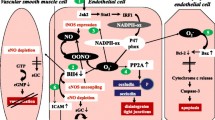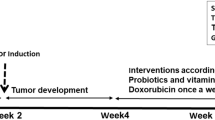The antioxidant formulation ethylmethylhydroxypyridine succinate (Mexidol) effectively neutralizes the radiolysis products of water and oxidative damage to DNA and proteins induced by X-irradiation. This substance was found to affect the formation of long-lived reactive forms of albumins and globulins and their degradation, which is accompanied by generation of hydrogen peroxide and an increase in the duration of oxidative stress after irradiation. Ethylmethylhydroxypyridine succinate has gene-protective and radiomitigating actions in vivo, decreasing the formation of micronuclei in polychromatophilic erythrocytes from red bone marrow in mice after irradiation, and is a potential therapeutic radiomitigating agent for preventing adverse effects due to impairments of redox homeostasis after irradiation.



Similar content being viewed by others
References
E. I. Azzam, J. P. Jay-Gerin, and D. Pain, Cancer Lett., 327(1–2), 48–60 (2012).
S. V. Gudkov, N. R. Popova, and V. I. Bruskov, Biofizika, 60(4), 801 – 811 (2015).
G. E. Hanumakumar, M. Balaji, and R. S. Karunakaran, Int. J. Pharm. Sci. Res., 9(7), 2656 – 2668 (2018).
M. V. Vasin and I. B. Ushakov, Usp. Sovr. Biol., 139(3), 235 – 253 (2019).
M. V. Vasin and I. B. Ushakov, Usp. Sovr. Biol., 140(1), 3 – 18 (2020).
D. Érlikh and N. A. Gratsianskii, Ratsional. Farmakoter. Kardiol., 10(4), 448 – 456 (2014).
T. A. Voronina, Ross. Med. Zh., 24(7), 434 – 438 (2016).
I. N. Smirnova, T. N. Fedorova, M. M. Tanashyan, and Z. A. Suslina, Atmosfera. Nervnye Bolezni, 1, 33 – 36 (2006).
E. V. Pozhilova, V. E. Novikov, and A. V. Novikova, Vestn. Smolensk. Gos. Med. Akad., 12(3), 56 – 66 (2013).
A. V. Shchul’kin, E. N. Yakusheva, and I. V. Chernykh, Zh. Nevrol. Psikhiat. im. S. S. Korsakova, 114(8), 70 – 73 (2014).
S. V. Gudkov, O. É. Karp, S. A. Garmash, et al., Biofizika, 57(1), 5 – 13 (2012).
V. I. Bruskov, O. E. Karp, S. A. Garmash, et al., Free Radic. Res., 46(10), 1280 – 1290 (2012).
I. N. Shtarkman, S. V. Gudkov, A. V. Chernikov, and V. I. Bruskov, Biokhimiya, 73(4), 576 – 586 (2008).
V. E. Ivanov, A. M. Usacheva, A. V. Chernikov, et al., J. Photochem. Photobiol. B: Biol., 176, 36 – 43 (2017).
V. I. Bruskov, A. V. Chernikov, V. E. Ivanov, et al., Phys. Wave Phenom., 28(2), 91 – 101 (2020).
V. E. Ivanov, A. V. Chernikov, C. V. Gudkov, and V. I. Bruskov, Biofizika, 63(5), 873 – 879 (2018).
A. Vral, M. Fenech, and H. Thierens, Mutagenesis, 26(1), 11 – 17 (2011).
N. F. Bunkin, N. V. Suyazov, A. V. Shkirin, et al., J. Chem. Phys., 130, 134308 (2009).
A. M. Moiseeva, I. V. Zhil’tsov D. V. Piskun, et al., Immunol. Allergol. Infektol., 4, 63 – 69 (2007).
I. Perez-Torres, V. Guarner-Lans, and M. E. Rubio-Ruiz, Int. J. Mol. Sci., 18, 2098 – 2124 (2017).
B. B. Moroz, Yu. B. Deshevoi, G. V. Sukoyan, et al., Radiats. Biol. Radioékol., 49(1), 90 – 96 (2009).
A. N. Grebenyuk, V. A. Basharin, R. A. Tarumov, et al., Vestn. Ros. Voen.-Med. Akad., 1(41), 102–106 (2013).
L. A. Il’in, Radiation Medicine, [in Russian], IzdAT, Moscow (2004).
Yu. B. Kudryashov, Radiation Biophysics, Ionizing Radiation [in Russian], Fizmatlit, Moscow (2004).
M. D. Brand, Free Radic. Biol. Med., 36(4), 429 – 434 (2016).
H. Sies, Redox Biol., 11(1), 613 – 619 (2017).
Author information
Authors and Affiliations
Corresponding author
Additional information
Translated from Khimiko-Farmatsevticheskii Zhurnal, Vol. 54, No. 7, pp. 10 – 14, July, 2020.
Rights and permissions
About this article
Cite this article
Karmanova, E.E., Chernikov, A.V., Usacheva, A.M. et al. Antioxidant and Gene-Protective Properties of Ethylmethylhydroxypyridine Succinate (Mexidol) in X-Ray Irradiation. Pharm Chem J 54, 673–677 (2020). https://doi.org/10.1007/s11094-020-02255-2
Received:
Published:
Issue Date:
DOI: https://doi.org/10.1007/s11094-020-02255-2




